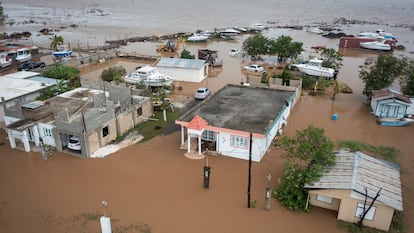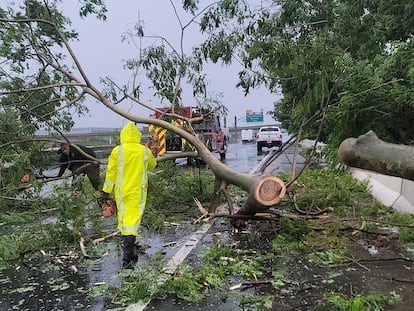From Maria to Fiona: The hurricane nightmare returns to Puerto Rico
More than a million people remain without power on the anniversary of the tropical cyclone that brought destruction to the US territory in 2017

Five years ago, Puerto Rico was in the dark. Hurricane Maria had passed through the island and destroyed the power grid, causing a massive blackout. Today, the nightmare is playing out again. More than a million people were without electricity and more than 800,000 without drinking water after the passage of Hurricane Fiona, which made landfall on the southwest coast of the country on Sunday afternoon. Two hours before the eye of the hurricane reached the US territory, the power grid collapsed. The island, which is still recovering from the damage caused by the 2017 cyclone, was left in the dark in the middle of a new emergency.
It is unclear how long Puerto Rico will be without electricity, but Governor Pedro Pierluisi said that he hopes the service will be restored in a matter of “days.” But the collapse of the power grid reopens one of the deepest wounds left by Hurricane Maria five years ago. On September 20, 2017, Maria crossed Puerto Rico as a Category 4 hurricane. It knocked out the island’s grid and caused, among other things, the longest blackout in Puerto Rico’s history. Some communities, especially those in the mountainous interior, went for more than a year without electricity or drinking water.
When it was finally possible to restore the service, it was done in a haphazard manner. There was no planning or design. “The network was left in a weakened state because it was rebuilt with whatever was available,” said Fabio Andrade, an electrical engineer and associate professor at the University of Puerto Rico in Mayagüez. “Fixes were done thinking that they would be temporary and that they would be improved later. But those improvements that should have been made were never made. So, now another hurricane comes along, and the network goes down again.”
We had five years after Maria to rebuild the network before another hurricane hit. It was not doneFabio Andrade, electrical engineer
Andrade predicted that restoring power after the passage of Fiona will be a slow process. “By allowing the entire island to go into a total blackout, the reboot process is going to take time. It is going to have to be reviewed line by line in order to gradually begin to build the network,” he warned.
This expert hopes that Fiona will serve as a warning to the government. “It will make them realize that this has to be fixed now. We had five years after Maria to rebuild the network before another hurricane hit. It was not done, and now we have seen that with any storm we are going to crash, because the island is not prepared,” said Andrade.
It was believed that the privatization of the system would be the solution for all the ills caused by Maria. But the reality is that since the private operator Luma took over, service interruptions have been constant, while the company has been steadily increasing the price of electricity. In just one year, customers have seen their bills soar by 58%. Now, the island finds itself relying on a company it doesn’t trust to restore power and prevent the blackout from lasting months.
“Catastrophic” damage
Puerto Ricans know that they can only rely on each other for help. They know that when roads are cut off by fallen trees, you grab a machete and cut the branches to clear the way. Or that when a river overflows its banks and traps a family, you have to find a boat that can cross the swollen river to rescue them. They learned it from Maria five years ago, and they are relearning it again with Fiona, which left up to 30 inches of water in different parts of the island after more than 24 hours of torrential rain. The storm’s winds uprooted power poles, felled trees and tore roofs from homes and businesses. There were landslides and floods, forcing thousands of residents from their homes. At least four people have died.
The island government is still in the process of assessing all the damage, but it has been described as “catastrophic” and is likely to run into the millions of dollars. On Sunday, US President Joe Biden declared a state of emergency for Puerto Rico, freeing up funds from the Federal Emergency Management Agency (FEMA) and authorizing this agency to coordinate disaster relief in the US territory.
On Tuesday, the US National Hurricane Center reported that Fiona was pummeling the Dominican Republic, with “heavy rainfall and life-threatening flash flooding still occurring” in eastern parts of the country. This center also warned that it was becoming “a major hurricane as it approaches the Turks and Caicos Islands.”
Tu suscripción se está usando en otro dispositivo
¿Quieres añadir otro usuario a tu suscripción?
Si continúas leyendo en este dispositivo, no se podrá leer en el otro.
FlechaTu suscripción se está usando en otro dispositivo y solo puedes acceder a EL PAÍS desde un dispositivo a la vez.
Si quieres compartir tu cuenta, cambia tu suscripción a la modalidad Premium, así podrás añadir otro usuario. Cada uno accederá con su propia cuenta de email, lo que os permitirá personalizar vuestra experiencia en EL PAÍS.
¿Tienes una suscripción de empresa? Accede aquí para contratar más cuentas.
En el caso de no saber quién está usando tu cuenta, te recomendamos cambiar tu contraseña aquí.
Si decides continuar compartiendo tu cuenta, este mensaje se mostrará en tu dispositivo y en el de la otra persona que está usando tu cuenta de forma indefinida, afectando a tu experiencia de lectura. Puedes consultar aquí los términos y condiciones de la suscripción digital.
More information
Últimas noticias
There is as much life left to discover on planet Earth as that which is already known
Dozens presumed dead, around 100 injured in fire at Swiss Alps bar during New Year’s celebration
Is porn for women different from conventional porn? We spoke to those who make it
Cartagena de Indias is sinking: What can the city do to mitigate it?
Most viewed
- David King, chemist: ‘There are scientists studying how to cool the planet; nobody should stop these experiments from happening’
- Reinhard Genzel, Nobel laureate in physics: ‘One-minute videos will never give you the truth’
- Oona Chaplin: ‘I told James Cameron that I was living in a treehouse and starting a permaculture project with a friend’
- Sinaloa Cartel war is taking its toll on Los Chapitos
- The Interoceanic Train, the Mexican alternative to the Panama Canal











































